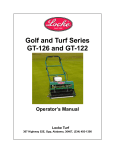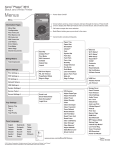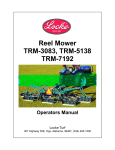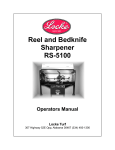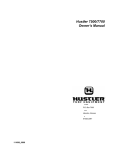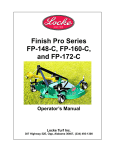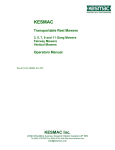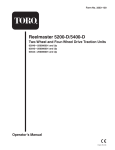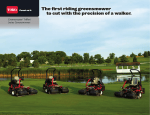Download Homelite UT80546 Pressure Washer User Manual
Transcript
Commercial Series Models 125,130 and 136 Operators Manual Locke Turf 307 Highway 52E, Opp, Alabama, 36467, (334) 493-1300 CONGRATULATIONS You have invested in the best implement of its type on the market today. The care you give your Locke Turf implement will greatly determine your satisfaction with its performance and its service life. We urge a careful study of this manual to provide you with a thorough understanding of you new implement before operating, as well as suggestions for operation and maintenance. If your manual should become lost or destroyed, Locke Turf will be glad to provide you with a new copy. Order from Locke Turf, 307 Highway 52E, Opp, Alabama 36467. As and Authorized Locke Turf dealer, we stock genuine Locke Turf parts which are manufactured with the same precision and skill as our original equipment. Our trained service personnel are well informed on methods required to service Locke Turf equipment, and are ready and able to help you. Should you require additional information or assistance, please contact us. YOUR AUTHORIZED LOCKE TURF DEALER BECAUSE LOCKE TURF MAINTAINS AN ONGOING PROGRAM OF PRODUCT IMPROVEMENT, WE RESERVE THE RIGHT TO MAKE IMPROVEMENTS IN DESIGN OR CHANGES IN SPECIFICATIONS WITHOUT INCURRING ANY OBLIGATION TO INSTALL THEM ON UNITS PREVIOUSLY SOLD. BECAUSE OF THE POSSIBILITY THAT SOME PHOTOGRAPHS IN THIS MANUAL WERE TAKEN OF PROTOTYPE MODELS, PRODUCTION MODELS MAY VARY IN SOME DETAIL. IN ADDITION, SOME PHOTOGRAPHS MAY SHOW SHIELDS REMOVED FOR PUR POSES OF CLARITY. NEVER OPERATE THIS IMPLEMENT WITHOUT ALL SHIELDS IN PLACE. Commercial Series Operator’s Manual Table of Contents SECTION Introduction ………….……………………...1 Warranty ………...…………….………….…..2 Safety Important Safety Information ……….……......3 Training ………………………………….…......3 Preparation ………………………………….....3 Operation ……………………………………....3 Maintenance and Storage ………….………...3 General Model 125 and 130 Mowers …………………4 How to Mow Your Lawn …………….………..4 Operation Starting the Engine …………………………....5 Raising and Lowering of Cutter Unit …….…..5 Height of Cut Adjustment ………………….....5 Mowing ………………………………………....5 Loading and Unloading for Transport …….…5 Maintenance Lubrication ………..…………………….………..6 Cleaning and Lubricating After Use ….…..…...6 Engine …………………………………...……….6 Bearings ………………………………………….6 Tractor Rolls ……………………………………..6 Tractor Tires ……………………………………..6 Tractor Chain Tension Adjustment ……………6 Clutches …...………………………………….….6 Reel Bedknife …………………………….……...7 Reel to Bedknife Adjustment ….… …………..7 Maintaining Blade Sharpness ….…...………....7 Backlapping - The Davidson Technique .. …..7 Resharpening Reels ……… …………..……...8 Resharpening Bedknives ………………….…...8 Sulky Sulky Assembly ………………………………….9 Sulky Installation ………………………………10 RETAIL CUSTOMER’S RESPONSIBILITY UNDER THE LOCKE TURF INC. WARRANTY It is the Retail Customer and /or Operator’s responsibility to read the Operator’s Manual, to operate, lubricate, maintain, and store the product in accordance with all instructions and safety procedures. Failure of the operator to read the Operator’s Manual is a misuse of this equipment. It is the Retail Customer and/or Operator’s responsibility to inspect the product and to have any part(s) repaired or replaced when continued operation would cause damage or excessive wear to other parts or cause a safety hazard. It is the Retail Customer’s responsibility to deliver the product to the authorized Locke Turf distributor from whom he purchased it, for service or replacement of defective parts that are covered by warranty. Repairs to be submitted for warranty consideration must be made within fort-five (45) days of failure. It is the Retail Customer’s responsibility for any cost incurred by the Dealer for traveling to or hauling of the product for the purpose of performing a warranty obligation or inspection. INTRODUCTION More than merely devices created for mowing grass, the excellence of design, construction and operation of Locke power mowers is unparalleled. First introduced in 1928, tested and proven, Locke power mowers may be considered, in terms of today’s technology, the ultimate response to the need for the highest degree of quality lawn care. These magnificent green machines are legendary and known throughout the world for generation-spanning durability and unequalled performance in the precision cutting of grass. Locke power mowers are heavy-duty, precision instruments. No capricious model year or cosmetic style changes are instituted, although improvements are continually incorporated into all models. The most recent evidence this is in the introduction of the new “Commercial Series”. Design and manufacturing innovations make this the mower for the next century. Whatever model of Locke power mower you have purchased you have our assurance that, with proper care, you are the owner of a machine which will provide many years of dependable service. To extract the fullest possible value from the performance of your Locke power mower we urge you to read this manual very carefully. Should you find any of the instructions unclear, please contact your Locke dealer or call the Locke Factory Service Department. Phone: 334-493-1300 Fax: 334-493-1400 Locke Reel Mowers: The Finest Cut….For The Finest Lawns 1 LOCKE MOWER Limited Warranty WARRANTY PERIOD AND COVERAGE A. Locke Turf, Inc. warrants to the original purchaser, and to subsequent owners, that the registered Locke Mower will be free from defects in materials and workmanship for a period of one (1) year from the date of purchase by the original owner. B. Locke Turf, Inc. will, at its discretion, replace any component or authorize the mower to be repaired, when a defect in material or workmanship has been determined. C. For this warranty to be effective, the mower must be registered, using the prescribed form, within ten (10) days of the original purchase. D. For this warranty to continue past the original owner, the factory must be notified of the new owners name, address, and phone number, along with the mower serial number, within ten (10) days of the purchase. WARRANTY EXCLUSIONS, LIMITATIONS AND RIGHTS A. Engines are not covered by this warranty but may be covered in separate warranties by their respective manufactures. B. Any failure resulting from accident, abuse, unauthorized modification, lack of reasonable maintenance as instructed in the Locke owners manual, or as a result of normal wear and tear is not covered by this warranty. C. This warranty is void if a part is used on the mower that is not specifically manufactured by or supplied by Locke Turf, Inc., whether related to a failure or not. D. This warranty is given in lieu of all other warranties, expressed or implied, including any warranties or merchantability or fitness for any particular purpose. E. Any implied warranties arising under state or federal laws shall be in effect only for the ninety (90) day period commencing on the date of sale of the mower to the original purchaser and shall terminate thereafter. F. The sole and exclusive remedy for any damage or injury resulting from alleged defects in materials or workmanship or for any breach of any expressed or implied warranty shall be to submit the mower or component part(s) for repair and/or replacement. All rights to any other remedy or damages including consequential, incidental and punitive damages are waived. G. The interpretation of this warranty and rights thereof is vested exclusively in Locke Turf, Inc. ADDITIONAL EXCLUSIONS A. Quality of cut and/or power loss will not be considered if reels and bed knives are not maintained to Locke Turf requirements. (See Reel and Bed knife Regrinding on page 8.) Locke Turf, Inc. Opp, Alabama USA 2 SECTION 1—SAFETY IMPORTANT SAFETY INFORMATION OPERATION This Safety Alert Symbol means: ATTENTION! BECOME ALERT! YOUR SAFETY IS INVOLVED! The Safety Alert Symbol identifies important safety messages in manuals and on equipment safety signs. To avoid possible injury or death, follow the equipment and manual’s safety instructions. In addition to the design and configuration of equipment, hazard control and accident prevention are dependent upon the awareness, concern, prudence and proper raining of personnel in the operation, transport, maintenance and storage of equipment. Read the operator’s manual for your safety and understanding of the equipment. Store the manuals in a safe and accessible location for your future reference. TRAINING 1. Read the operating and service instruction manual carefully. Be thoroughly familiar with controls and the proper use of the equipment. 2. Never allow children to operate a power mower. 3. Keep the area of operation clear of all persons, particularly small children, and pets. PREPARATION 1. Thoroughly inspect the area where the equipment is to be used and remove all stones, sticks, wires, bones, and other foreign objects. 2. Do not operate the equipment when barefoot or wearing open sandals. Always wear substantial footwear. 3. Check the fuel before starting the engine. Do not fill the gasoline tank indoors, when the engine is running, or while the engine is still hot. Wipe of any spilled gasoline before starting the engine. 4. Disengage the self-propelled mechanism or drive clutch on units so equipped before starting the engine. 5. Never attempt to make a height adjustment while the engine is running. 6. Mow only in daylight or in good artificial light. 7. Never operate the equipment in wet grass. Always be sure of your footing; keep a firm hold on the handle and walk; never run. 1. Do not change the engine governor settings or over speed the engine. 2. Do not put hands or feet near or under rotating parts. Keep clear of the discharge opening at all times. 3. Stop the blades when crossing gravel drives, walks, or roads. 4. After striking a foreign object, stop the engine, remove the wire from the spark plug, thoroughly inspect the mower for any damage, and repair the damage before restarting and operating the mower. 5. If the equipment should start to vibrate abnormally, stop the engine and check immediately for the cause. Vibration is generally a warning of trouble. 6. Stop the engine whenever you leave the equipment, before cleaning the mower, and when making any repairs or inspections. 7. When cleaning, repairing, or inspecting, make certain the blades and all moving parts have stopped. Disconnect the spark plug wire, and keep the wire away from the plug to prevent accidental starting, 8. Do not run the engine indoors. 9. Shut the engine off and wait until the blades come to a complete stop before removing the grass catcher. 10. Mow across the face of slopes; never up and down. Exercise extreme caution when changing direction on slopes. Do not mow excessively steep slopes. 11. Never operate the mower without proper guards, plates, or other safety protective devices in place. MAINTENANCE AND STORAGE 1. Check the engine mounting bolts at frequent intervals for proper tightness. 2. Keep all nuts, bolts, and screws tight to be sure the equipment is in safe working condition. 3. Never store the equipment with gasoline in the tank inside a building where fumes may reach an open flame or spark. Allow the engine to cool before storing in any enclosure. 4. To reduce fire hazard, keep the engine free of grass, leaves, or excessive grease. CAUTION SOME ILLUSTRATIONS MAY SHOW SHIELDS OR COVER PANELS REMOVED FOR CLARITY. NEVER OPERATE UNIT WITHOUT ALL SHILDS AND COVER PANELS IN PLACE. 3 SECTION 2—GENERAL MODEL 125, 130, AND 136 MOWERS HOW TO MOW YOUR LAWN The Locke “Commercial Series” mowers are the most practical for small areas, cut-up lawns, flower gardens, cemeteries, schools, etc. They do a complete job in one operation: overhang raised borders, cut close to obstructions, leave no uncut rolled down grass; eliminating hand trim operations and they even have the ability to cut a taper; useful when transitioning two different heights of cut. We recommend that the direction of mowing a lawn be changed from time to time so that the same pattern of the tractor rolls will not always be over the same grass. The first mowing should be made in one direction; with subsequent mowing directions being made at right angles to the prior mowing. Occasionally it is advised to mow in a diagonal pattern which will have a tendency to even out the rolling effect on the lawn. NOTE: In this booklet all right or left designations are made from the operators position. 4 SECTION 3—OPERATION STARTING THE ENGINE Check to see that the oil in the crankcase is at the proper level and there is fuel in the tank. Make sure that the tractor clutch lever, on the right handlebar, and the reel clutch lever, on the left handlebar, are released before attempting to start the engine. Set the engine kill switch to the on position, move the throttle to a slightly open position, close the carburetor choke valve, then pull on the recoil starter rope. After a few seconds warm up, place the choke valve in the run position and adjust the throttle to the desired speed. For further instructions, refer to the engine manufacturers manual. To move the mower around under its own power, grip the tractor clutch lever applying slight pressure, this will start the mower moving in a forward direction. When the desired direction of movement has been established, fully engage the clutch hand lever. The same procedure is applied to the reel engagement lever on the left handlebar. The speed of the mower is governed by engine speed. To mow at a slower pace, simply reduce the engine RPM. The frequency of cut will be constant throughout the engine speed. Vary the pressure of the tractor clutch lever for increased maneuverability around obstacles, in other words “slip the clutch”. RAISING AND LOWERING OF CUTTER LOADING AND UNLOADING FOR TRANSUNIT PORT To elevate the cutter unit for transport or storage, pull the hand lever, located on the handlebar cross member, over center towards the operator. When the cutter unit is set at its highest setting, the aluminum roller will clear a hard surface by approximately 1/2”. If more clearance is required it may be necessary to adjust the height of the cutter unit. (Refer to “Height of Cut Adjustment” below). To lower the cutter unit, push the hand lever away from the operator until the cutter unit settles on the ground. To load the mower either on a trailer or truck, the ramp should be of an angle slight enough not to allow the reel to strike the ramp, possibly causing damage to the reel unit. Also, it is advisable to raise the height roller to the uppermost position. After positioning the mower in the desired location, lower the reel unit. This allows for better balance and also reduces the chance of damage to the lifting mechanism. Secure the mower with quality tie-downs. HEIGHT OF CUT ADJUSTMENT Adjustment of the cut height is a simple operation. To adjust, kill the engine, raise the cutter unit, push the adjustment handle against the spring pressure, holding CAUTION the handle firmly in place while allowing the smaller diameter of the pin to track through to the desired cut WHEN UNLOADING DOWN A RAMP, USE THE height. Release hand pressure on the handle and the TRACTOR CLUTCH LEVER AS A BRAKE TO spring pressure will hold the pin in place. The range of CONTROL YOUR SPEED. MAKE SURE OF adjustment is 1/2”-3” in 1/4” increments. YOUR PATH BEFORE PROCEEDING DOWN THE RAMP. MOVE SLOWLY. MOWING CAUTION THE TRACTOR AND REEL ENGAGEMENT LEVERS HAVE OPERATOR PRESENCE SAFETY FEATURES. WHEN THE LEVER IS RELEASED IT WILL RETURN TO THE NEURAL POSITION. IF THEY ARE NOT FUNCTIONING AS SUCH, DO NOT OPERATE THE MOWER UNTIL THE PROBLEM IS RECTIFIED. 5 SECTION 4—MAINTENANCE as reel link arms, reel bearing housings, etc. have sintered bronze bushings. LUBRICATION There are 4 pressure lubrication points on the mower. All are zerk type grease fittings. Use a quality light grease at these points. The bronze clutch collars each have a grease fitting. These are located at the front of the tractor on the left and right sides underneath the main guard. Lubricate with 1 or 2 shots of grease every 10 hours of operation. The caster post has a fitting. It is located just above the attachment point of the caster wheel. Lubricate this every 20 hours of operation. The last fitting is located on the differential, between the rolls or tires depending on how your mower is equipped. Lubricate this every 100 hours of operation. Keep all chains well lubricated with a thin lubrication oil. It is best to lubricate them after each mowing or every 4 hours of use. This prevents rusting while standing idle and allows the oil to penetrate to the pin and bearings by capillary action. When a chain is operated without lubricant, the chain will wear prematurely and the elongated chain will in turn wear the sprockets to conform to the pitch of the chain. Worn chains make expensive repairs because the sprockets as well as the chains must be replaced. Proper lubrication will give you many years of trouble-free service. CLEANING AND LUBRICATING AFTER USE When cutting is finished, clean the machine. It is much easier to clean now than later. This is a good time to oil the chains and lubricate the mower, allowing the oil to penetrate and the grease to flush out grit. If a high pressure wash down is used it is imperative to lubricate thoroughly after cleaning. Inspect the mower for any loose or worn components and replace if necessary. If you do not understand the mechanics of the mower, contact your dealer for service. AVOID spraying water directly into clutch housing, as this will decrease life expectancy. TRACTOR ROLLS The tractor rolls are in reality hard rubber tires. They are mounted on a single axle which drives them through differential gears. The differential is composed of two steel bevel gears and two steel pinions with hardened teeth, fully enclosed and packed in grease. TRACTOR TIRES There are four pneumatic tires in place of the rollers. Tire pressure should be set at 10 psi cold. TRACTOR CHAIN TENSION ADJUSTMENT On occasion it is necessary that slack be taken up on the tractor chain. Tension should be adjusted so that there is a slight movement by hand pressure. Excessive tension will result in loss of power and premature wear on components. To adjust the tractor chain, loosen the bolt on the chain adjuster and push on the plastic block until the desired tension is achieved. (See figure below) Tighten the bolt to secure the tensioner block. When the chain has elongated to the point of using all of the adjustment, it will be necessary to take out a link of chain. LOOSEN BOLT ENGINE The operating and maintenance instructions for the Kohler, Briggs and Stratton or Honda engine are explained in a manual furnished by the engine manufacturer which is included in the information packet you received with your mower. NOTE: All engines are shipped WITHOUT fluids and must be added prior to starting. Refer to engine manual for instructions about adding oil to the gear reduction crank case if applicable. BEARINGS All parts that constantly rotate are carried on ball bearings. The reel, clutch shaft, height roller and roller axle have permanently sealed bearings. The reel chain idlers and caster wheel are carried on semi-precision bearings and may require lubrication. Pivot points such 6 CLUTCHES The clutches are dry multi disc type, limited load, enclosed and non adjustable, using molded friction discs, hardened dogs and cone and bronze shifting collar. REEL BEDKNIFE MAINTAINING BLADE SHARPNESS Whenever the bed knife is replaced it is essential that the reel and blade be ground or lapped to alignment. To provide consistent performance, lap the cutter blades on a regular basis, ideally after every 40 to 60 hours of operation. Your dealer will be able to assist you in maintaining Locke’s legendary cut. If you have the equipment to lap your reel, follow the steps below. 1. Loosen the reel adjusting screws enough to cause a slight friction on the bed knife. 2. Attach a lapping motor to the reel. A lapping motor is a device that spins the reel in reverse at approximately 125 rpm. (Use Lapping Adapter P/N 5102). 3. Saturate a brush with lapping compound and apply it to the reel. 4. Continue lapping until the reel runs without the Intermittent grinding sounds caused by high spots. 5. Thoroughly clean all lapping compound from the cutter unit. 6. Reset the adjusting screws so that the reel blades just touch the bed knife. Each blade should cleanly cut a piece of newspaper at all points across the bed knife. REEL TO BEDKNIFE ADJUSTMENT The cutting reel is mounted on sealed ball bearings. These bearings are carried in brackets hinged to the reel side plates. The hinged brackets have springs which urge the reel blades toward the stationary blade (See figure below). An adjustable stop screw limits the swing of these brackets and hence the approach of the reel blades to the stationary blade. The correct setting is when these blades just touch each other. Always strive to maintain “light” reel to bed knife contact. Note: If the blades rub together too heavily, the wear is excessive and the power to drive them increases with the pressure. If the blades are too far apart, it is impossible to cut grass. The tendency will be to munch the grass and wedge it between the reel and bed knife. BACKLAPPING —THE DAVIDSON TECHNIQUE In cases when it is impractical to power-back-lap, a safe, alternate method is possible. Practical for Locke single reel mowers, the Davidson technique allows for lapping without any special tools or equipment. “QUICK ADJUST HANDLE” Required Tools and Materials “QUICK ADJUST” PIN Wrenches and pliers for engine chain removal Wrenches (2) for reel to bed knife adjustment Lapping compound (80 or 120 grit, water soluble) Brush for applying compound to reel blades REEL ADJUSTMENT SCREW To Proceed 1. Select a large hard surfaced area, such as a driveway or garage floor. 2. Remove the engine chain from the mower. 3. Loosen and reset the reel adjusting screws (2) enough to cause a slight friction between reel and bed knife. (Make sure that this is done equally on both sides of the reel.) 4. Saturate a brush with lapping compound and apply it to the reel. 5. Engage both clutches, and slowly pull mower backwards to initiate lapping action. 6. When you have pulled mower back to a stopping point, disengage at least one clutch and push mower back up to the starting point. 7. Repeat step 5 until the reel runs without the intermittent grinding sounds caused by high spots. 8. Thoroughly rinse all compound from reel and mower and allow to dry. 9. It may be necessary to reset the adjusting screws so that the reel blades just touch the bed knife. Each blade should cleanly cut a piece of paper at all points REEL TO BEDKNIFE CLEARANCE HEIGHT ROLLER 7 Resharpening Reels Re-sharpening Bed knives For maximum performance and to achieve the finest cut, reels should be reground with a relief. For best results, the “land” area should be no wider than 1/64” to begin the season. (See figure below) Modern reel grinders are capable of producing a relief, finishing off the cylinder with a light spin grind. Depending on the amount of use, bed knives may be re-sharpened once or twice before replacing them is necessary. Regrind both top and front faces to the specifications shown. (See figure below) When replacing bed knives, the new knives must be sharpened after they have been bolted to the bed bar, before they are reinstalled in the cutting unit. NOTE: Warranty claims relating to quality of cut or power loss will not be considered if reels are operated without a relief grind. 8 Sulky Attachment (Optional) To assemble your Sulky Attachment please use the CL Series Parts Manual as a guide in addition to this literature. Pivot Tube Pivot Bosses 1. Place the #2 Pivot Tube between the Pivot Bosses of the Frame Weldment #1. Figure 1 Figure 1 2. Place (1) Spring Bushing #9 in each Pivot Boss. From the rear, install Pivot Shaft #3 thru the frame and Pivot Gusset #2 lining up the holes and install the Retainer bolt #18 and secure with Nut #17. Figure 2 2 18 17 3 3. Install Seat Spring #6 over Reinforcement #7 and attach with (2) Bolts #20 and (2) Nut #11. Install the Seat #8 in one of the 3 mounting holes with #19 and #16. Figure 3 9 9 Figure 2 19 4. Install Tire/Wheel Assembly in order of Washer #22, Wheel #13, Washer #22, and (2) Nuts #14. Figure 4 8 6 20 16 7 1 11 22 14 22 13 Figure 4 9 Figure 3 Installing Your Sulky Attachment 1. Remove Caster Assembly and Grease Fitting. Figure 5 2. Install Lower Vertical Pivot Clamp #5 in place of the Caster Assembly and lock in place with (2) Setscrews #15. Install (1) Bearing Cup Assembly #10 in the Pivot Clamp #5 using Bolt #12 and Nut #11. 15 10 5 12 11 Figure 6 2 3. Install Sulky by placing Sulky Gusset #2 in the Bearing Cup Assembly #10 of Lower Vertical Pivot Clamp #5, then install Upper Vertical Pivot Clamp #4 over Sulky Gusset #2 and around traction unit frame tube with a second #10, #11 and #12. Tighten all bolts and grease the (6) grease fittings. Figure 7 10 11 12 4 Figure 8 10 11 12 Locke Turf 307 Highway 52E, Opp, Alabama, 36467, (334) 493-1300
















